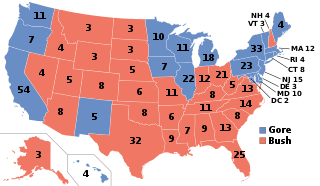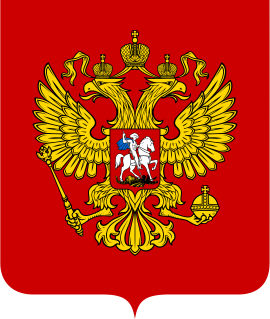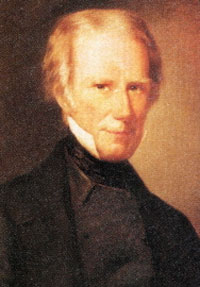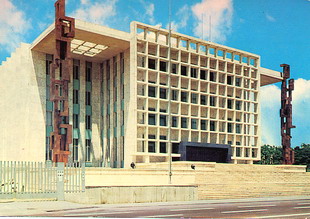
The 2000 United States presidential election was the 54th quadrennial presidential election. It was held on Tuesday, November 7, 2000. Republican candidate George W. Bush, the Governor of Texas and the eldest son of the 41st President George H. W. Bush, won the election by defeating Democratic nominee Al Gore, the incumbent vice president. It was the fourth of five presidential elections in which the winning candidate lost the popular vote, and is considered one of the closest elections in US history.

The United States Electoral College is a body of electors established by the United States Constitution, constituted every four years for the sole purpose of electing the president and vice president of the United States. The Electoral College consists of 538 electors, and an absolute majority of 270 electoral votes is required to win an election. Pursuant to Article II, Section 1, Clause 2, the legislature of each state determines the manner by which its electors are chosen. Each state's number of electors is equal to the combined total of the state's membership in the Senate and House of Representatives; currently there are 100 senators and 435 representatives. Additionally, the Twenty-third Amendment provides that the District of Columbia (D.C.) is entitled to a number of electors no greater than that of the least populous state.

A first-past-the-post electoral system is one in which voters indicate on a ballot the candidate of their choice, and the candidate who receives the most votes wins. This is sometimes described as winner takes all. First-past-the-post voting is a plurality voting method. FPTP is a common, but not universal, feature of electoral systems with single-member electoral divisions, and is practiced in close to one third of countries. Notable examples include Canada, India, the United Kingdom, and the United States, as well as most of their current or former colonies and protectorates.

On the federal level, Russia elects a president as head of state and a legislature, one of the two chambers of the Federal Assembly. The president is elected for, at most, two consecutive six-year terms by the people. The Federal Assembly has two chambers. The State Duma has 450 members, elected for five-year terms, using a system of proportional representation, where parties gain a percentage of seats equal to the percentage of national votes they gained, with a 7% threshold required to gain any seats in the Duma. The Federation Council is not directly elected; each of the 85 federal subjects of Russia sends 2 delegates to the Federal Council, for a total of 170 members.

The 2004 United States presidential election was the 55th quadrennial presidential election, held on Tuesday, November 2, 2004. Incumbent Republican President George W. Bush defeated Democratic nominee John Kerry, a United States Senator from Massachusetts.

The New Zealand general election of 1914 was held on 10 December to elect a total of 80 MPs to the 19th session of the New Zealand Parliament. The Maori vote was held on 11 December. A total number of 616,043 voters were registered, of which 84.7% voters turned out to vote.

Elections to the United States House of Representatives for the 15th Congress were held in the various states between April 1816 and August 14, 1817. The Congress first met on December 1, 1817.

The 2012 United States presidential election was the 57th quadrennial American presidential election, held on Tuesday, November 6, 2012. The Democratic nominee, President Barack Obama, and his running mate, Vice President Joe Biden, were elected to a second term. They defeated the Republican ticket of former Governor Mitt Romney of Massachusetts and Representative Paul Ryan of Wisconsin.

In 2000, the United States presidential election in New Jersey, along with every U.S. state and Washington, D.C., took place on November 7, 2000. It was the 54th U.S. presidential election. The major party candidates were Democratic Vice President Al Gore of the incumbent administration and Republican Governor of Texas George W. Bush, son of the 41st U.S. president, George H. W. Bush. Owing to the indirect system of voting used in U.S. presidential elections, George W. Bush narrowly defeated Gore in Electoral College votes despite that Gore earned a higher percentage of the popular vote. Green Party candidate Ralph Nader, the only third-party candidate represented on most states' ballots, came in a distant third.

The 2016 United States presidential election was the 58th quadrennial American presidential election, held on Tuesday, November 8, 2016. The Republican ticket of businessman Donald Trump and Indiana Governor Mike Pence defeated the Democratic ticket of former Secretary of State Hillary Clinton and U.S. Senator from Virginia Tim Kaine, despite losing the popular vote. Trump took office as the 45th President, and Pence as the 48th Vice President, on January 20, 2017.
The United States Senate elections of 1802 and 1803 were elections for the United States Senate which had the Democratic-Republican Party assume an overwhelming control thereof.
The 1812 United States House of Representatives elections in New York were held from December 15 to 17, 1812, to elect 27 U.S. Representatives to represent the State of New York in the United States House of Representatives of the 13th United States Congress. At the same time, a vacancy was filled in the 12th United States Congress.
The 1816 United States House of Representatives elections in New York were held from April 23 to 25, 1816, to elect 27 U.S. Representatives to represent the State of New York in the United States House of Representatives of the 15th United States Congress. At the same time, a vacancy was filled in the 14th United States Congress.
The 1821 United States House of Representatives elections in New York were held from April 24 to 26, 1821, to elect 27 U.S. Representatives to represent the State of New York in the United States House of Representatives of the 17th United States Congress.

The United States Senate elections of 1788 and 1789 were the first elections for the United States Senate, which coincided with the election of President George Washington. As of this election, formal organized political parties had yet to form in the United States, but two political factions were present: The coalition of senators who supported George Washington's administration were known as "Pro-Administration," and the senators against him as "Anti-Administration."
The 1824 United States House of Representatives elections in New York were held from November 1 to 3, 1824, to elect 34 U.S. Representatives to represent the State of New York in the United States House of Representatives of the 19th United States Congress.

The 2012 United States presidential election in New Jersey took place on November 6, 2012, as part of the 2012 General Election in which all 50 states plus The District of Columbia participated. New Jersey voters chose 14 electors to represent them in the Electoral College via a popular vote pitting incumbent Democratic President Barack Obama and his running mate, Vice President Joe Biden, against Republican challenger and former Massachusetts Governor Mitt Romney and his running mate, Congressman Paul Ryan.

The 2018 United States Senate elections were held on November 6, 2018. Thirty-three of the 100 seats were contested in regular elections while two others were contested in special elections due to Senate vacancies in Minnesota and Mississippi. The winners were elected to six-year terms running from January 3, 2019, to January 3, 2025. Senate Democrats had 26 seats up for election while Senate Republicans had nine seats up for election.
Donald E. Burkhart Jr. is an American politician and a Republican member of the Wyoming House of Representatives representing District 15 since January 11, 2011.

The next general election in the United Kingdom is scheduled to be held on 5 May 2022 under the Fixed-term Parliaments Act 2011. The election may be held at an earlier date in the event of an early election motion being passed by a super-majority of two-thirds in the House of Commons, or a vote of no confidence in the government which is not followed by a vote of confidence within 14 days.














